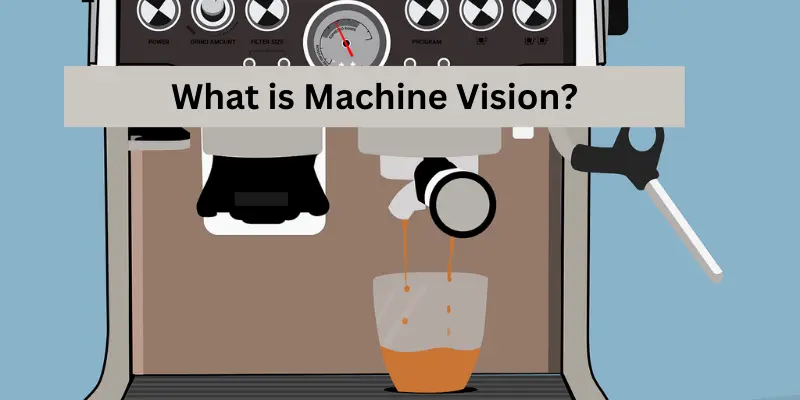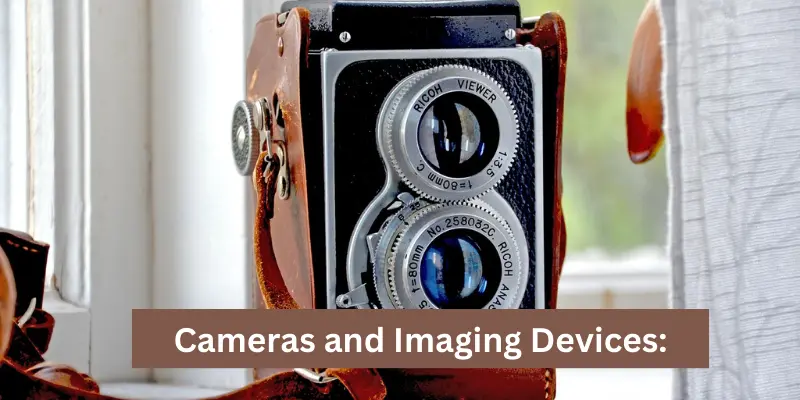What is Machine Vision? – A Comprehensive Guide
Published: 01 Jan 2025
In today’s rapidly advancing technological landscape, machines are increasingly gaining the ability to “see” and make intelligent decisions based on visual data.
This remarkable capability is powered by machine vision, a technology that enables automated systems to capture, process, and interpret images. Whether in manufacturing, healthcare, or autonomous vehicles, machine vision is reshaping industries by automating tasks that traditionally required human sight and decision-making. What is Machine Vision?

What is Machine Vision?
Machine vision refers to a technology that allows machines and systems to interpret and analyze visual data, much like humans do. It involves the use of cameras, sensors, lighting, and software algorithms to process images and make decisions based on the data captured. Unlike human vision, which relies on the brain to process visual information, machine vision systems are powered by advanced computational systems and algorithms.
At its core, machine vision allows a system to “see,” identify objects, detect anomalies, measure items, and even interpret complex visual patterns without human intervention. These systems are integral to applications where speed, precision, and consistency are critical, such as in industrial automation, autonomous vehicles, medical imaging, and quality control processes What is Artificial Intelligence and How is it Used?
How Does Machine Vision Work?
Machine vision systems operate through a series of steps, from image capture to analysis and decision-making. Let’s break down how these systems work in a clear and simple way.
Image Capture
The first step in the machine vision process is image capture. Cameras and imaging devices, such as digital cameras, infrared cameras, or even 3D scanners, are used to capture visual data. The quality of the captured image is crucial, as it affects the system’s ability to analyze the visual data accurately.
In some cases, multiple cameras are used to capture images from different angles or depths, providing a more comprehensive understanding of the environment or object being analyzed.
Image Preprocessing
Once the image is captured, it often needs to be preprocessed. Preprocessing involves enhancing the image to ensure it’s clear and free of noise or distortions that could hinder accurate analysis. This step may include: what machine learning can do
- Noise reduction to eliminate unwanted data.
- Brightness and contrast adjustment to highlight key features.
- Edge detection to identify the boundaries of objects.
- Filtering to sharpen details or remove unnecessary information.
Feature Extraction
After preprocessing, the system performs feature extraction, where it identifies and isolates the most important visual features in the image. These features might include: What is the Future of Artificial Intelligence & Machine (L)
- Edges that mark the boundaries of objects.
- Shapes, such as circles or rectangles.
- Textures that describe surface patterns.
- Colors, useful for distinguishing different objects or parts.
- Feature extraction enables the system to isolate relevant information and discard irrelevant data.
Image Analysis and Decision-Making
Now comes the critical part: image analysis. Using advanced algorithms, machine vision software processes the extracted features to make sense of the image. This could involve:
Pattern recognition to identify objects.
- Dimensional analysis to measure sizes or distances.
- Defect detection to spot flaws or irregularities in manufactured parts.
- Based on the analysis, the system can make a decision. For example, it could determine whether a product meets quality standards or whether an object is in the correct location.
Action Based on Analysis
The final step is taking action based on the system’s decision. This could involve:
- Rejecting a defective product on an assembly line.
- Sorting items based on size or shape.
- Providing feedback to an operator in real-time.
- Triggering another automated process, like moving a part to the next stage in production.
- Machine vision systems can work autonomously, enabling high-speed, high-precision tasks without the need for human intervention.
Key Components of a Machine Vision System
A machine vision system typically consists of several key components that work together to enable visual perception and decision-making. These components include:
Cameras and Imaging Devices:

In machine vision, cameras and imaging devices serve as the “eyes” that enable machines to perceive their surroundings. These devices capture visual data, allowing the system to gather crucial information about objects, environments, or processes. machine learning explained
Different Types for Different Tasks:
Just as humans use different types of glasses to see clearly, machine vision systems use various types of cameras to suit specific needs. For example, standard 2D cameras are typically used for capturing flat images or videos of objects, while 3D cameras can create depth maps to understand the shape and volume of objects, ideal for precise measurements or complex shapes. Infrared cameras, on the other hand, detect heat rather than visible light, allowing the system to “see” temperature variations, which is helpful in applications like detecting overheating components or inspecting surfaces.
High-Resolution for Precision:
The resolution of the camera is key in machine vision. Higher-resolution cameras capture more detailed images, helping the system identify even the smallest defects or details. This is particularly important in quality control, where spotting a tiny crack or flaw can make a huge difference. machine learning complete info
Smart Sensors for Clarity:
Along with the cameras, smart sensors often enhance the system’s ability to capture accurate data. These sensors might measure the intensity of light, detect motion, or adjust the focus automatically, ensuring that the images are sharp and clear no matter the lighting conditions. advantages of artificial intelligence
Backlighting:
This involves shining light from behind the object to highlight its edges and make features easier to identify.
Lighting: Illuminating the Path to Accuracy
Proper lighting is a crucial component of any machine vision system, as it directly influences the quality of the images captured by the cameras. Without appropriate lighting, even the most advanced cameras would struggle to capture clear and accurate data.
Uniform Lighting: Ensuring even illumination across the object or scene helps reduce shadows and highlights, making it easier for the system to detect features and defects.
Backlighting: This technique involves lighting the object from behind to highlight its edges and contours. It’s especially useful for detecting transparent objects or parts with complex shapes.
Structured Lighting: This specialized lighting creates patterns (such as grids or stripes) on the object’s surface, which helps the vision system create more precise 3D maps of the object, ideal for measurement tasks.
Diffuse and Directional Lighting: Diffuse lighting spreads light evenly, while directional lighting focuses light in specific areas. Depending on the application, different lighting methods can be used to enhance visibility of certain features.
By carefully choosing the right lighting, machine vision systems ensure that objects are captured in the best possible condition for accurate analysis.
Image Processing Unit:
The image processing unit is the heart and soul of a machine vision system. It consists of both hardware and software that work together to analyze the visual data captured by the cameras.
Hardware:
This typically involves high-performance computers or industrial PCs designed to handle large volumes of image data and run complex algorithms in real time. These systems are equipped with powerful graphics processing units (GPUs) that accelerate image processing, allowing for faster analysis and decision-making.
Software:
The software that powers the machine vision system runs sophisticated algorithms that interpret the captured images. These algorithms perform tasks like pattern recognition, anomaly detection, feature extraction, and object measurement. Over time, machine vision software can also learn and adapt, improving its accuracy and performance with machine learning techniques.
Applications of Machine Vision
Machine vision is a powerful technology with widespread applications across various industries. Here are some of the most common applications:
Manufacturing and Quality Control
Machine vision is revolutionizing manufacturing by automating tasks like quality inspection, assembly, and packaging. Automated machine vision systems can inspect thousands of products per minute, detecting defects such as cracks, misalignment, or color inconsistencies. They can also measure dimensions to ensure products meet strict quality standards.
Autonomous Vehicles
In the field of autonomous vehicles, machine vision plays a crucial role in helping self-driving cars understand their surroundings. Cameras and sensors collect data about road signs, traffic lights, pedestrians, and other vehicles. The machine vision system processes this data in real time, enabling the vehicle to make decisions about navigation, speed, and obstacle avoidance.
Medical Imaging
Machine vision is also transforming the healthcare industry. Medical imaging systems use machine vision to analyze X-rays, MRIs, CT scans, and other medical images. This helps radiologists detect abnormalities such as tumors, fractures, or infections with greater speed and accuracy.
Robotics and Automation
Robots rely heavily on machine vision to perform tasks like picking, placing, and assembling components. For example, in warehouses, robots use vision systems to identify items, grab them, and move them to the correct location. This kind of automation boosts efficiency, reduces errors, and lowers labor costs.
Agriculture
Machine vision is increasingly being used in precision agriculture to monitor crop health, detect diseases, and automate harvesting processes. Drones equipped with machine vision systems can scan large fields, collecting valuable data on soil moisture, plant growth, and pest infestations.
Advantages of Machine Vision Systems
Machine vision systems offer numerous benefits, making them indispensable in various industries. Here are some of the key advantages:
High Accuracy: Machine vision systems can detect even the smallest defects or anomalies that might go unnoticed by the human eye.
Increased Speed and Efficiency: These systems can process images and make decisions at high speeds, automating repetitive tasks and boosting productivity.
Consistency and Reliability: Unlike humans, machine vision systems don’t get tired or make errors due to fatigue, ensuring consistent performance.
Cost Savings: Though the initial investment can be high, machine vision systems can help businesses save money in the long run by reducing labor costs, minimizing errors, and improving product quality.
Challenges of Machine Vision Systems
While machine vision systems are incredibly powerful and useful, they do come with certain challenges. These challenges can affect their performance and may require additional effort to overcome. Let’s take a look at some of the common obstacles:
Limited Flexibility in Complex Environments
Problem: Machine vision systems are typically trained to recognize specific objects or patterns. In dynamic or unpredictable environments, these systems may struggle to adapt to new or unfamiliar objects.
Example: A machine vision system trained to detect one type of part might have trouble recognizing a new part that’s slightly different in shape or size.
Lighting Issues
- Problem: Proper lighting is essential for capturing clear images. If the lighting is uneven or too dim, the system may struggle to detect objects correctly.
- Example: A camera might have difficulty identifying defects on a shiny metal surface if the lighting is too harsh or poorly placed.
Complex Setup and Calibration
Problem: Setting up and calibrating machine vision systems can be complex. It involves adjusting cameras, lighting, and software to work together seamlessly.
Example: If the camera isn’t aligned properly or the software isn’t calibrated, the system might misinterpret the visual data, leading to errors.
High Initial Costs
Problem: The cost of high-quality cameras, sensors, and software can be expensive, making it a significant investment for businesses, especially smaller ones.
Example: A small company may hesitate to invest in a machine vision system due to the upfront costs, even though the long-term benefits could outweigh the expense.
Environmental Factors
Problem: Harsh environments, like dusty or noisy factories, can interfere with the performance of machine vision systems. Dust, vibrations, or extreme temperatures may affect cameras and sensors.
Example: In a factory where dust is common, cameras might get dirty quickly, reducing image quality and accuracy.
The Future of Machine Vision
As AI and machine learning continue to evolve, machine vision systems are becoming smarter and more capable. The integration of deep learning algorithms allows machine vision systems to recognize more complex patterns and adapt to new situations, making them even more powerful.
The future of machine vision is also closely tied to the rise of Industry 4.0, where connected systems communicate and adapt in real-time. Machine vision will continue to play a key role in automating industries, reducing human labor, and improving efficiency.
Conclusion
Machine vision is a transformative technology that empowers machines to “see” and make decisions based on visual data, revolutionizing industries across the board. From inspecting products on assembly lines to enabling autonomous vehicles to navigate complex environments, machine vision systems are driving innovation, enhancing accuracy, and boosting efficiency. What is Machine Vision?
1. What is the primary function of a machine vision system?
a) To interpret and analyze visual data automatically
b) To create digital images for entertainment
c) To produce high-quality cameras
d) To generate sound waves for navigation
2. What type of camera would you use to capture the 3D structure or depth of an object?
a) 2D Camera
b) Thermal Camera
c) 3D Camera
d) Motion Camera
3. Which of the following is a key component of a machine vision system that helps improve the quality of captured images?
a) Software
b) Lighting
c) Actuators
d) Sensors
4. What does “edge detection” in machine vision help with?
a) Finding the fastest production speed
b) Identifying boundaries of objects
c) Improving the image’s brightness
d) Identifying different colors in an image
5. Which industry benefits the most from using machine vision for quality control and defect detection?
a) Fashion
b) Healthcare
c) Manufacturing
d) Entertainment
6. What is one of the challenges of machine vision systems in industrial environments?
a) Too many cameras
b) High-resolution images
c) Harsh environmental factors like dust and vibration
d) Lack of data storage
7. What type of machine vision system is most commonly used for detecting temperature differences or heat patterns?
a) Infrared Camera
b) 3D Camera
c) High-Speed Camera
d) Color Vision System
8. How does machine vision benefit industries in terms of speed and efficiency?
a) By reducing the number of workers needed
b) By capturing images faster than human eyes
c) By creating more complex designs
d) By decreasing the overall image quality
9. Which of the following best describes the software used in machine vision systems?
a) It stores and organizes visual data only
b) It processes images and performs tasks like pattern recognition and defect detection
c) It only provides real-time feedback to operators
d) It replaces the need for cameras entirely
10. What is the term for adjusting and fine-tuning the components of a machine vision system, like cameras and lighting, to ensure they work properly?
a) Calibration
b) Rebooting
c) Virtualization
d) Streamlining
Results:
- 8-10 Correct: Visionary Expert! You have a strong understanding of machine vision and its applications.
- 5-7 Correct: Vision Enthusiast! You know the basics and are on your way to mastering machine vision.
- 0-4 Correct: Vision Explorer! It’s time to dive deeper into the fascinating world of machine vision!
Answer:
Machine vision refers to the ability of a system to capture and interpret visual data to make decisions automatically, without human intervention. It is often used in industrial, medical, and automotive applications to automate tasks like inspection, measurement, and analysis.
A machine vision system typically includes cameras, lighting, image processing hardware, and software. The cameras capture images or videos of objects or scenes, which are then processed by specialized algorithms to extract important features, detect anomalies, or identify patterns. The software interprets this data and can trigger actions based on predefined criteria, such as sorting products on a production line, guiding robotic arms, or identifying defects in manufacturing.
Answer:
While machine vision systems offer incredible benefits, they also come with a set of challenges:
Lighting Conditions: Proper lighting is crucial for capturing clear images. Insufficient or uneven lighting can make it difficult for the system to distinguish objects or detect defects accurately.
Calibration and Setup: Configuring and calibrating a machine vision system to work perfectly with cameras, sensors, and software can be time-consuming and complex. Any misalignment or error in calibration can lead to inaccurate results.
Environmental Factors: Harsh conditions, such as dust, dirt, or extreme temperatures, can interfere with camera sensors and reduce image quality, leading to system malfunction or decreased performance.
Cost: High-quality cameras, sensors, and processing units can be expensive, making machine vision systems a significant investment, especially for smaller businesses.
Despite these challenges, the benefits of machine vision—such as improved accuracy, speed, and efficiency—make it an invaluable tool in many industries.
What is Machine Vision?
Proudly powered by WordPress






